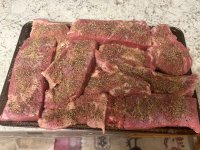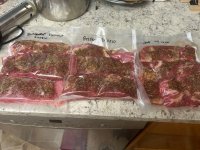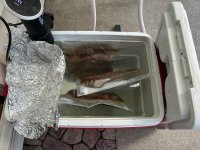Your plate might work but circulating the water is important. It's an underwater version of convection. Keeps things more even.Is constant stirring or liquid flow necessary for the cooking to work properly?
Even so, I still rotate if there are multiple bags in there.
Any way to know Joe is to try.
Some have a setting for moist items. It get collected in a tray and keeps it away from the guts of the machine.that prevents liquids from clogging the pump (done that once).
$100 or less for a wand.before investing in more expensive equipment.
Brisket this time. 30 hours at 132F. You'll note I didn't waste time spreading it as it will make its own way around when the moisture and myoglobin start to surface.
Attachments
Last edited:
I have news for you Mark. That's how everyone does it.to see his little trick.
If it's dry content, you can do it a similar way by using a straw.
Really, na, another fallacy.the intense heat in the tandoor seals the surface
Yes, there are so many wives tales that have been put to the test and proven just plain wrong. Meat cooking has a whole book just on it's own. I remember my Mother cringing when I deep fried my bacon. She couldn't wrap her head around that it was the best way to remove the fat. Same with deep frying a steak. It's the second best way to cook one, after immersion.
Last edited:
BTW, if anyone is questioning, look it up. Deep frying a steak is the only fast way to do the desired moisture entrapment and allow the 'steaming' of the inside part of the meat. You end up with what true beef lovers want.
Only the uninformed think this introduces more fat into their diet.
Again, please read up before posting against this.
Science beats Mom and Dad thinking.
Only the uninformed think this introduces more fat into their diet.
Again, please read up before posting against this.
Science beats Mom and Dad thinking.
Last edited:
Please do not use zip lock bags to cook, the heat deflection temperature of LDPE is about 80 degrees Celsius. Or about 175 F....
Zip lock bags here are usually LDPE, there will be a recycling mark with some information about the material on each bag, usually a number within the recycling symbol, or name, sometimes both.
A quote off the net:
LDPE is defined by a density range of 917–930 kg/m3. At room temperature it is not reactive, except to strong oxidizers; some solvents cause it to swell. It can withstand temperatures of 65 °C (149 °F) continuously and 90 °C (194 °F) for a short time.
As an experienced plastics processor, I can say these figures are within range, specific grades may vary slightly.
There are additives like talcum powder / chalk powder which are added to bags here for increasing output and adding stiffness to film, and many other grades exist, including three layer milk pouch film (milk is sold in pouches here for the most part), though in that the inner layer is without additives.
Pouches are tamper evident, recyclable, no refill / wash as in bottles, and usually do not break like glass bottles.
Zip lock bags here are usually LDPE, there will be a recycling mark with some information about the material on each bag, usually a number within the recycling symbol, or name, sometimes both.
A quote off the net:
LDPE is defined by a density range of 917–930 kg/m3. At room temperature it is not reactive, except to strong oxidizers; some solvents cause it to swell. It can withstand temperatures of 65 °C (149 °F) continuously and 90 °C (194 °F) for a short time.
As an experienced plastics processor, I can say these figures are within range, specific grades may vary slightly.
There are additives like talcum powder / chalk powder which are added to bags here for increasing output and adding stiffness to film, and many other grades exist, including three layer milk pouch film (milk is sold in pouches here for the most part), though in that the inner layer is without additives.
Pouches are tamper evident, recyclable, no refill / wash as in bottles, and usually do not break like glass bottles.
Again, I repeat, please verify the bag material and its thermal properties before using it as a cooking vessel.
Cal: I suggest you take a small piece of the marinaded or otherwise prepared meat, and instead of cooking it in your low temperature / slow cook style, have a portion of the same item cooked in a tandoor, if you somebody who will do it for you as a favor.
Then tell us you opinion.
Cal: I suggest you take a small piece of the marinaded or otherwise prepared meat, and instead of cooking it in your low temperature / slow cook style, have a portion of the same item cooked in a tandoor, if you somebody who will do it for you as a favor.
Then tell us you opinion.
How about silicone? Like the stuff some baking trays (muffins) and sheets are made of?Again, I repeat, please verify the bag material and its thermal properties before using it as a cooking vessel.
Baking takes a few minutes for cupl cakes etc.
Slow cooling meat in a cross linked rubber compound is not something I would do, until the maker specifically says those bags are good for hours.
Silicon rubber has a high temperature rating. But foil printing blocks and food contact are two quite different things.
Please bear in mind that there are thousands of blends in rubber, so it is difficult to be specific, it needs a specific grade property detail, and some of those are confidential.
I would use a closed steel box for that kind of cooking, or foil.
That is my opinion, I defer to people who actually have used them.
Also, like tobacco, it takes time for the damage to show, please bear that in mind.
Slow cooling meat in a cross linked rubber compound is not something I would do, until the maker specifically says those bags are good for hours.
Silicon rubber has a high temperature rating. But foil printing blocks and food contact are two quite different things.
Please bear in mind that there are thousands of blends in rubber, so it is difficult to be specific, it needs a specific grade property detail, and some of those are confidential.
I would use a closed steel box for that kind of cooking, or foil.
That is my opinion, I defer to people who actually have used them.
Also, like tobacco, it takes time for the damage to show, please bear that in mind.
Some have a setting for moist items. It get collected in a tray and keeps it away from the guts of the machine.
Yes, mine always had have that.... it works for "moist" stuff, but sometimes, if you have too much liquid it will get into the pump and ruin it.
What I want is something that can do dry, moist and wet liquids... for that you need the chamber vacuum machine.
I am guessing that's why they say moist rather than wet. I have noticed that even dry rubs will become wet in the bag so I try not to add any moisture even if I want a 'brine'. It will do it on its own.it works for "moist" stuff,
As I noted earlier, with my current vacuum machine, if I want a brine or sauce in the sous vide I mix it and freeze it first, then add it into the bag at the last minute.
But the root solution will be a chamber vacuum machine... which will have to wait as I want an espresso only grinder and I need to replace the broken food slicer first...
But the root solution will be a chamber vacuum machine... which will have to wait as I want an espresso only grinder and I need to replace the broken food slicer first...
And that's fine but I don't like seeing the hydrogen that releases into my sous vide bag. It looks like I didn't seal it properly and creates a certain buoyancy just as it does when frozen. It's probably just an appearance thing but it looks like I have been sloppy in my prep.I mix it and freeze it first, then add it into the bag at the last minute.
It's like sausage.... you don't want to know how it was made nor what's inside... just enjoy it.
My sous vide oven, a "Sous Vide Supreme", the big one, comes with racks so you can hold the bag submerged if it develops buoyancy...
BTW, I just checked their prices.... Whoa!!... talk about inflation!!!!
My sous vide oven, a "Sous Vide Supreme", the big one, comes with racks so you can hold the bag submerged if it develops buoyancy...
BTW, I just checked their prices.... Whoa!!... talk about inflation!!!!
I know what's there because I put it there.It's like sausage.... you don't want to know how it was made nor what's inside...
Attachments
- Home
- Member Areas
- The Lounge
- The food thread



